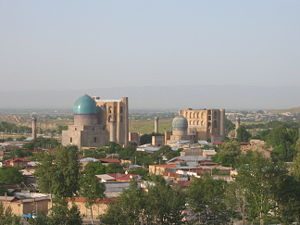|
|
|
|
|
|
|
|
|
|
|
|
Samarkand (1)Uzbekistan - Asia

Samarkand The city is most noted for its central position on the Asian Shadow of the Silk Road between China and the west and for being an Islamic centre for scholarly study. The Bibi-Khanym Mosque remains one of the city's most famous landmarks. The Registan was the ancient centre of the city. Tajiks make up the majority in Samarkand. It is located at the altitude of 702 meters. In 2001, UNESCO inscribed the 2750-year-old city on the World Heritage List as Samarkand - Crossroads of Cultures. Etymology Samarkand derives its name from the Old Persian asmara, "stone", "rock", and Sogdian kand, "fort", "town". History Samarkand is one of the oldest inhabited cities in the world, prospering from its location on the trade route between China and Europe (Silk Road). At times Samarkand has been one of the greatest cities of Central Asia. Founded circa 700 BC it was already the capital of the Sogdian satrapy under the Achaemenid dynasty of Persia when Alexander the Great conquered it in 329 BC (see Afrasiab, Sogdiana). Although a Persian-speaking region, it was not united politically with Iran between the times of Alexander and the Arab conquest. The Greeks referred to Samarkand as Maracanda. In the 6th Century it was within the domains of a Turkish kingdom. At the start of the 8th century Samarkand came under Arab control. Under Abbasid rule, the legend goes, the secret of papermaking was obtained from two Chinese prisoners from the Battle of Talas in 751, which led to the first paper mill in the Islamic world to be founded in Samarkand. The invention then spread to the rest of the Islamic world, and from there to Europe. 
Samarkand - the Registan A small part of the population survived, but Samarkand suffered at least another Mongol sack by Khan Baraq to get treasure he needed to pay an army with. The town took many decades to recover from these disasters. In 1365 a revolt against Mongol control occurred in Samarkand. In 1370, Timur the Lame, or Tamerlane, decided to make Samarkand the capital of his empire, which extended from India to Turkey. During the next 35 years he built a new city and populated it with artisans and craftsmen from all of the places he had conquered. Timur gained a reputation as a patron of the arts and Samarkand grew to become the centre of the region of Transoxiana. During this time the had a population of about 150,000. In 1499 the Uzbekhs took control of Samarkand. The Shaybanids emerged as the Uzbekh leaders at or about this time. In the 16th century, the Shaybanids moved their capital to Bukhara and Samarkand went into decline. After an assault by the Persian king, Nadir Shah, the city was abandoned in the 18th century, about 1720 or a few years latter. From 1784 Samarkand was ruled by the emirs of Bukhara.[9] The city came under Russian rule after the citadel had been taken by a force under Colonel Alexander Abramov in 1868. Shortly thereafter the small Russian garrison of 500 men were themselves besieged. The assault, which was led by Abdul Malik Tura, the rebellious elder son of the Bukharan Emir, and Bek of Shahrisabz, was beaten off with heavy losses. Abramov, now a general, became the first Governor of the Military Okrug which the Russians established along the course of the River Zeravshan, with Samarkand as the administrative centre. The Russian section of the city was built after this point, largely to the west of the old city. The city later became the capital of the Samarkand Oblast of Russian Turkestan and grew in importance still further when the Trans-Caspian railway reached the city in 1888. It became the capital of the Uzbek SSR in 1925 before being replaced by Tashkent in 1930. In 1939 Samarkand had a population of 134,346.
All text is available under the terms of the GNU Free Documentation License (see Copyrights for details). About Wikipedia Disclaimers 2007 Site Index Back to Top Photos Index Thanks for coming, I hope you
have enjoyed it, will recommend
it to your friends, and will come
back later to see my site developing
and expanding.
|